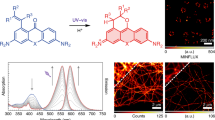Abstract
Sub–diffraction-limit imaging can be achieved by sequential localization of photoactivatable fluorophores, for which the image resolution depends on the number of photons detected per localization. We report a strategy for fluorophore caging that creates photoactivatable probes with high photon yields. Upon photoactivation, these probes can provide 104−106 photons per localization and allow imaging of fixed samples with resolutions of several nanometers. This strategy can be applied to many fluorophores across the visible spectrum.
This is a preview of subscription content, access via your institution
Access options
Subscribe to this journal
Receive 12 print issues and online access
$259.00 per year
only $21.58 per issue
Buy this article
- Purchase on Springer Link
- Instant access to full article PDF
Prices may be subject to local taxes which are calculated during checkout



Similar content being viewed by others
References
Hell, S.W. Science 316, 1153–1158 (2007).
Huang, B., Babcock, H. & Zhuang, X. Cell 143, 1047–1058 (2010).
Klar, T.A. & Hell, S.W. Opt. Lett. 24, 954–956 (1999).
Gustafsson, M.G.L. Proc. Natl. Acad. Sci. USA 102, 13081–13086 (2005).
Rust, M.J., Bates, M. & Zhuang, X. Nat. Methods 3, 793–795 (2006).
Betzig, E. et al. Science 313, 1642–1645 (2006).
Hess, S.T., Girirajan, T.P.K. & Mason, M.D. Biophys. J. 91, 4258–4272 (2006).
Fölling, J. et al. Nat. Methods 5, 943–945 (2008).
Heilemann, M., van de Linde, S., Mukherjee, A. & Sauer, M. Angew. Chem. Int. Ed. Engl. 48, 6903–6908 (2009).
Dempsey, G.T., Vaughan, J.C., Chen, K.H., Bates, M. & Zhuang, X.W. Nat. Methods 8, 1027–1036 (2011).
Patterson, G., Davidson, M., Manley, S. & Lippincott-Schwartz, J. Annu. Rev. Phys. Chem. 61, 345–367 (2010).
Hoyer, P., Staudt, T., Engelhardt, J. & Hell, S.W. Nano Lett. 11, 245–250 (2011).
Yildiz, A. et al. Science 300, 2061–2065 (2003).
Pertsinidis, A., Zhang, Y. & Chu, S. Nature 466, 647–651 (2010).
Tiers, G.V.D. & Wiese, J.A. Jr. US Patent 3,916,069 (1975).
Kundu, K. et al. Angew. Chem. Int. Ed. Engl. 48, 299–303 (2009).
Vogelsang, J. et al. ChemPhysChem 11, 2475–2490 (2010).
Ries, J., Kaplan, C., Platonova, E., Eghlidi, H. & Ewers, H. Nat. Methods 9, 582–584 (2012).
Engelhardt, J. et al. Nano Lett. 11, 209–213 (2011).
Enderlein, J., Toprak, E. & Selvin, P.R. Opt. Express 14, 8111–8120 (2006).
Huang, B., Jones, S.A., Brandenburg, B. & Zhuang, X. Nat. Methods 5, 1047–1052 (2008).
Huang, B., Wang, W., Bates, M. & Zhuang, X. Science 319, 810–813 (2008).
Bates, M., Huang, B., Dempsey, G.T. & Zhuang, X. Science 317, 1749–1753 (2007).
Galston, A.W. Proc. Natl. Acad. Sci. USA 35, 10–17 (1949).
Vogelsang, J. et al. Angew. Chem. Int. Ed. Engl. 47, 5465–5469 (2008).
Rasnik, I., McKinney, S.A. & Ha, T. Nat. Methods 3, 891–893 (2006).
Patil, P.V. & Ballou, D.P. Anal. Biochem. 286, 187–192 (2000).
Acknowledgements
We thank T. Mitchison, M. Ericsson and W. Wang for help during this project. This work is supported in part by the US National Institutes of Health and a Collaborative Innovation Award from the Howard Hughes Medical Institute (to X.Z.). J.C.V. is supported in part by a Burroughs-Wellcome Career Award at the Scientific Interface. X.Z. is a Howard Hughes Medical Institute investigator.
Author information
Authors and Affiliations
Contributions
J.C.V. is primarily responsible for experimental design. J.C.V. and S.J. performed experiments and analysis. X.Z. supervised and guided the project. J.C.V. and X.Z. wrote the manuscript.
Corresponding author
Ethics declarations
Competing interests
The authors declare no competing financial interests.
Supplementary information
Supplementary Text and Figures
Supplementary Figures 1–9, Supplementary Note and Supplementary Protocol (PDF 9669 kb)
Rights and permissions
About this article
Cite this article
Vaughan, J., Jia, S. & Zhuang, X. Ultrabright photoactivatable fluorophores created by reductive caging. Nat Methods 9, 1181–1184 (2012). https://doi.org/10.1038/nmeth.2214
Received:
Accepted:
Published:
Issue Date:
DOI: https://doi.org/10.1038/nmeth.2214
This article is cited by
-
Raster-scanning Donut simplifies MINFLUX and provides alternative implement on other scanning-based microscopes
Light: Science & Applications (2022)
-
IBEX: an iterative immunolabeling and chemical bleaching method for high-content imaging of diverse tissues
Nature Protocols (2022)
-
Non-invasive super-resolution imaging through dynamic scattering media
Nature Communications (2021)
-
Molecular resolution imaging by post-labeling expansion single-molecule localization microscopy (Ex-SMLM)
Nature Communications (2020)
-
An order of magnitude faster DNA-PAINT imaging by optimized sequence design and buffer conditions
Nature Methods (2019)



